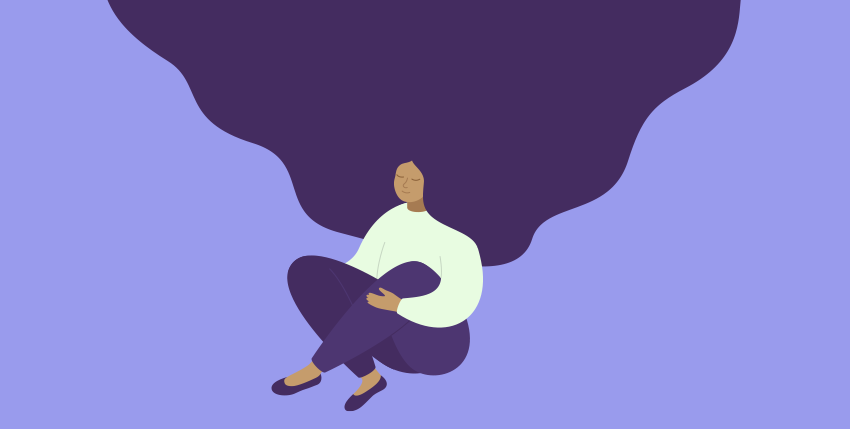Americans are the most stressed people in the world, according to an annual Gallup poll that was conducted prior to the coronavirus pandemic. Gallup’s 2019 Global Emotions Report found that about 55 percent of adults in the United States said they had experienced stress during “a lot of the day” prior, compared with just 35 percent globally. Since the 2019 report, the amount of daily stress has only increased for the majority of Americans due to the COVID-19 pandemic.
Almost everyone has been affected by the coronavirus pandemic in some way whether that’s through illness, losing loved ones or jobs, and/or being confined at home. We’ve had to get used to a new way of working, exercising, relaxing, interacting with friends and family, and just living our lives in general. Life as we knew it has been completely upended due to COVID-19, and for many of us the adjustment hasn’t been easy.
Nearly 8 in 10 (78%) of American adults say that the coronavirus pandemic is a significant source of stress in their life, according to a Stress in AmericaTM survey conducted by the Harris Poll on behalf of the American Psychological Association (APA). And 2 in 3 adults (67%) say that they have experienced increased stress over the course of the pandemic.
Understanding Stress
“Stress is how the brain and body respond to any demand. Any type of challenge – such as performance at work or school, a significant life change, or a traumatic event – can be stressful,” according to the National Institute of Mental Health. “Everyone experiences stress from time to time. There are different types of stress – all of which carry physical and mental health risks.”
In certain situations, stress can serve a specific purpose and actually be helpful. That’s because in stressful circumstances, our stress hormones – such as cortisol and epinephrine – rise, which revs our system up and allows us to be able to respond appropriately.
However, too much stress and the resulting release of stress hormones can wear us down and make us both mentally and physically sick.
The Physical Toll Of Stress
While we’re often more focused on the emotional toll of chronic stress, the greater danger may lie in the physical toll, according to Sharp Health News.
Constant stress can have real physical effects on our body, and it has been linked to a wide range of health issues such as mood, sleep, and appetite problems, as well as heart disease. Stress can also cause headaches, muscle tension (especially in our neck, shoulders, and back), acne (or other skin problems), digestion problems, increased or decreased nutrition (leading to weight gain or weight loss), a rise in blood pressure, and a change in our heart rate. These physical results of chronic stress take a toll on all of our body’s systems, including muscular, respiratory, cardiovascular, endocrine, gastrointestinal, nervous, and reproductive systems.
That’s why it’s so important for us to combat the effects of stress with proven stress relief strategies that will benefit both our mind and body. So, let’s take a look at five fun ways to relax and de-stress.
5 Fun Ways To De-Stress
1. Use Guided Imagery As A Way To Escape To Your ‘Happy Place’
Guided imagery pretty much allows you to transport to another world without physically leaving the space you’re in.
“Guided imagery is like taking a short vacation in your mind,” according to Verywell Mind. “It can involve imagining yourself being in your ‘happy place’ – maybe picturing yourself sitting on a beach, listening to the waves, smelling the ocean, and feeling the warm sand underneath you.”
It can either be done by listening to a recording of someone who will walk you through a peaceful scene, or you can practice guided imagery on your own. All you have to do is close your eyes for a few minutes and take yourself through a calm, peaceful scene. Make sure to allow yourself to truly feel as though you’re really there and think about all the things you’d do in your special place. Then after a few minutes, open your eyes and return to the present moment. You can also set a timer for yourself before you start doing your guided imagery session. This way you can be fully present in your happy place without feeling like you have to keep track of time.
2. Embrace Hugs From Your Family and Friends (And Cuddles From Your Pets)
Hugs have the ability to relive stress and pain as they can create a calming or relaxing feeling. This is due to the release of oxytocin (also known as the “cuddle hormone”) when loved ones or pets snuggle up next to us. The oxytocin release has been found to potentially reduce inflammation, improve wound healing, lower stress, and also lower our heart rates.
“Hugging increases serotonin, a neurotransmitter known as the ‘feel good’ hormone,” according to Golden Valley Health Centers. “It is produced and spread by neurons in the brain that help us feel happy, calm, and confident. When serotonin levels are high, we feel good about ourselves. Low levels of serotonin can cause sleep disorders, depression, and lead to obesity.”
Therefore, it’s possible that a hug a day just might keep the doctor away since hugging triggers the release of serotonin to create happiness and help diminish sad feelings. So, if you’re feeling stressed or down, find a loved one to hug or a pet to cuddle. And then notice how your mood improves for the better right away.
3. Make Art (Or Do Something Creative)
A study that investigated the impact of visual art making on the cortisol levels of 39 healthy adults found that about 75 percent of the participants experienced a decrease in their cortisol levels after 45 minutes of making art – regardless of their artistic experience.
“Participants’ written responses indicated that they found the art-making session to be relaxing, enjoyable, helpful for learning about new aspects of self, freeing from constraints, an evolving process of initial struggle to later resolution, and about flow/losing themselves in the work,” according to the article published in the Journal of the American Art Therapy Association. “They also reflected that the session evoked a desire to make art in the future.”
Similar to physical exercise, creative stimulation engages and focuses our minds on the task at hand – and distracts us from feelings of stress and anxiety.
“When you create, you invoke your imagination, which is a productive and constructive use of your mind,” according to an Entrepreneur article. “By focusing intensely on a creative task, you can achieve the state of ‘flow,’ the term coined by psychologist Mihaly Csikszentmihalyi, and which is typically defined as the ‘optimal state of consciousness where we feel our best and perform our best.’”
So, if you’ve been noticing yourself feeling more stressed than usual lately, mix things up a bit and do something creativity. Learn how to play piano or guitar, buy a watercolor set and paper and just start doodling, or try a new recipe for dinner or dessert. Make sure to enjoy the process, and allow yourself to be a beginner again. There’s no need to judge your work as you’re making it, or after. The beauty is in the creation. And before you know it, magic will start to happen and you’ll achieve the state of ‘flow.’
4. Practice Yoga And Give Mindfulness Meditation A Try
Yoga is a mind-body practice that combines physical poses, controlled breathing, and meditation or relaxation. Practicing yoga may lead to improved balance, flexibility, range of motion, and strength, reduce stress and anxiety, and also help reduce risk factors for chronic diseases such as heart disease and high blood pressure. And best of all, almost anyone can do yoga.
“Many people turn to yoga when feelings of anxiety start to creep in or during times of stress,” according to Healthline. “You may find that focusing on both your breath and your ability to be present in each pose can help quiet negative mental chatter and boost your overall mood.”
While meditation is a part of yoga, which deals with mental relaxation and concentration, you may also want to try mindfulness meditation without the yoga poses.
“Meditation is a simple practice available to all, which can reduce stress, increase calmness and clarity, and promote happiness,” according to The New York Times. “Learning how to meditate is straightforward, and the benefits can come quickly.”
Mindfulness meditation involves paying close attention to your thoughts, emotions, and sensations in the present moment. When you’re first getting started, it may be beneficial to listen to guided meditations since instructions from an experienced teacher can help remind us to come back to the present moment if/when we get distracted. Remember that mindfulness mediation isn’t about letting your thoughts wander, and it isn’t about trying to empty your mind either. It’s about being in the present moment.
5. Sit Back, Relax, and Enjoy The Show (And Laugh A Lot)
“Laughter is a natural medicine that can improve your mood, strengthen your immune system, and even combat stress,” according to a University of St. Augustine For Health Sciences article.
When you get stressed, your body tenses up and can cause you to feel stuck. A good laugh can relieve physical tension in your body and relax your muscles for up to 45 minutes. Laughter also has the ability to distract you – providing your brain with a break from whatever thoughts you’ve been worrying about, improve your mood by producing a general sense of well-being, and reduce stress hormones since laughter can decrease cortisol levels.
So, sit back, relax, and laugh a lot as you enjoy your favorite funny TV show, movie, or stand-up comedy special. You can also call up a friend who always makes you laugh, watch funny videos on the Internet, or even laugh at yourself when you do something silly. By not taking life too seriously all the time, you might just find yourself feeling less stressed out in the long run. And if all else fails, buy a stress ball and squeeze it to allow your body to release your tension in the moment.







